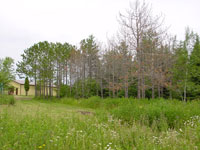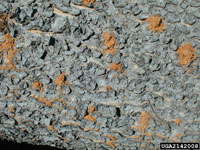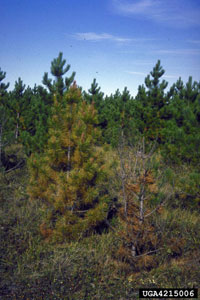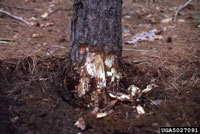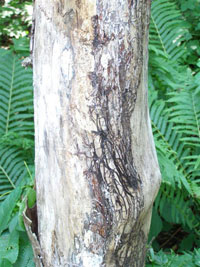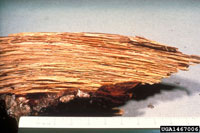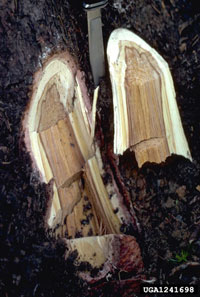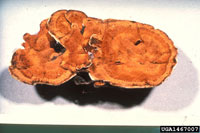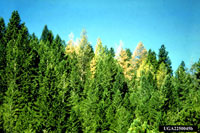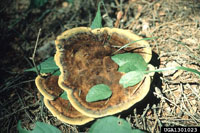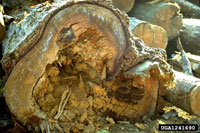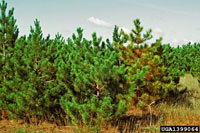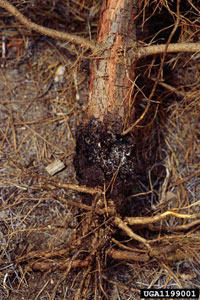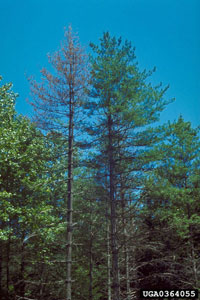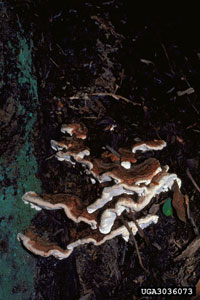Extension > Garden > Diagnose a problem > What's wrong with my plant? > Evergreen Trees and Shrubs > Pine > Slow growth, discolored needles
Pine > Needles > Slow growth, discolored needles, thin canopy throughout the entire tree
1 of 6
Ips bark beetles
Ips spp..
- Adults bore numerous holes less than 1/8 inch diameter in bark which can resemble being shot by a BB gun or shot gun
- Entrance holes often have a reddish-brown, resin-soaked fine sawdust
- Larvae feed under bark
- Needles turn yellow and reddish-brown
- Adults are dark brown to black and range in size from about 1/8 to ¼ of an inch long
- Favors stressed pines of all species
- More information on Ips bark beetles
2 of 6
Armillaria root rot
Armillaria spp.
- Infected trees have reduced growth, discolored needles, thin canopies; produce large amount of cones and eventually die
- Flat white sheets of fungal growth (mycelial fans) between the bark and sapwood at the base of infected trees
- Base of tree may be encrusted in resin
- Thick, black shoestring-like fungus can sometimes be seen under the bark at the root collar and in the soil near the base of the tree
- Wood is decayed, white, soft and spongy, beginning with the roots and may extend from the base of the tree well up into the trunk
- Trees frequently break or fall over in storms
- Clusters of honey-colored mushrooms may grow at the base of the tree in fall
- More information on Armillaria root rot
3 of 6
Tomentosus root rot
Onnia tomentosa
- Infected trees have reduced growth, discolored needles, thin canopies; produce large amount of cones and eventually die
- Heartwood of infected roots and trunks decays, initially turning reddish-brown
- As infection continues white pocket rot develops; decayed wood has elongated pockets or pits and may appear honeycomb-like in cross section
- Affected trees are often scattered, not adjacent
- Infected trees frequently break or lodge during storms
- Large mushrooms, velvety brown above and porous, buff-colored below occur at base of tree or above decaying roots some distance away
- More information on Tomentosus root rot
4 of 6
Brown root and butt rot
Phaeolus schweinitzii
- Slow growth, thin canopy and discolored needles in severely infected trees
- Infection causes decay of heartwood in trunk and roots
- Decaying wood has brown, cubical rot
- Affected trees are often scattered, not adjacent
- Infected trees frequently break or lodge in storms
- 10"-12" fungal conk growing on trunk or several feet away from tree, velvety dark brown above and porous, light brown underneath
- Most pines and conifers are susceptible
- More information on Brown root and butt rot
5 of 6
Pine root collar weevil
Hylobius radicis
- Large amounts of pitch are exuded, darkening the root collar and nearby soil
- Discolored needles, from yellow to reddish-brown on entire tree
- Infested trees often tip due to feeding damage
- Most pine attacked; prefers pine growing on sandy soils with heavy grass competition
- Adults are ¼ inch long, reddish brown to black with whitish to yellowish spots (patches of scale); has conspicuous snout
- Larvae about ⅓ inch long, whitish and grub-like
- More information on Pine root collar weevil
6 of 6
Heterobasidion root disease and butt rot
Heterobasidion irregulare (previously known as H. annosum)
- Slow growth, thin canopy, and discolored needles in severely infected trees
- Resin soaked bark at base of tree
- Sapwood of roots and butt discolored brown
- Groups of infected trees commonly found in area where trees have been removed
- Wood decays with a stringy white rot
- Trees eventually die, windthrow common
- Popcorn like white fungal structures that grow into leathery fungal conk, white to reddish brown above, cream colored with multiple pores below
- Fungal conks common on cut stumps but often rare on infected trees
- Infects most pines and other conifers
- Not yet identified in Minnesota; if found, contact Arrest the Pest: 1-888-545-6684 or Arrest.the.Pest@state.mn.us
- More information on Heterobasidion root disease and butt rot



